Cheng Luo
Generative Diffusion Contrastive Network for Multi-View Clustering
Sep 11, 2025Abstract:In recent years, Multi-View Clustering (MVC) has been significantly advanced under the influence of deep learning. By integrating heterogeneous data from multiple views, MVC enhances clustering analysis, making multi-view fusion critical to clustering performance. However, there is a problem of low-quality data in multi-view fusion. This problem primarily arises from two reasons: 1) Certain views are contaminated by noisy data. 2) Some views suffer from missing data. This paper proposes a novel Stochastic Generative Diffusion Fusion (SGDF) method to address this problem. SGDF leverages a multiple generative mechanism for the multi-view feature of each sample. It is robust to low-quality data. Building on SGDF, we further present the Generative Diffusion Contrastive Network (GDCN). Extensive experiments show that GDCN achieves the state-of-the-art results in deep MVC tasks. The source code is publicly available at https://github.com/HackerHyper/GDCN.
LabelGS: Label-Aware 3D Gaussian Splatting for 3D Scene Segmentation
Aug 27, 2025Abstract:3D Gaussian Splatting (3DGS) has emerged as a novel explicit representation for 3D scenes, offering both high-fidelity reconstruction and efficient rendering. However, 3DGS lacks 3D segmentation ability, which limits its applicability in tasks that require scene understanding. The identification and isolating of specific object components is crucial. To address this limitation, we propose Label-aware 3D Gaussian Splatting (LabelGS), a method that augments the Gaussian representation with object label.LabelGS introduces cross-view consistent semantic masks for 3D Gaussians and employs a novel Occlusion Analysis Model to avoid overfitting occlusion during optimization, Main Gaussian Labeling model to lift 2D semantic prior to 3D Gaussian and Gaussian Projection Filter to avoid Gaussian label conflict. Our approach achieves effective decoupling of Gaussian representations and refines the 3DGS optimization process through a random region sampling strategy, significantly improving efficiency. Extensive experiments demonstrate that LabelGS outperforms previous state-of-the-art methods, including Feature-3DGS, in the 3D scene segmentation task. Notably, LabelGS achieves a remarkable 22X speedup in training compared to Feature-3DGS, at a resolution of 1440X1080. Our code will be at https://github.com/garrisonz/LabelGS.
Chinese Court Simulation with LLM-Based Agent System
Aug 24, 2025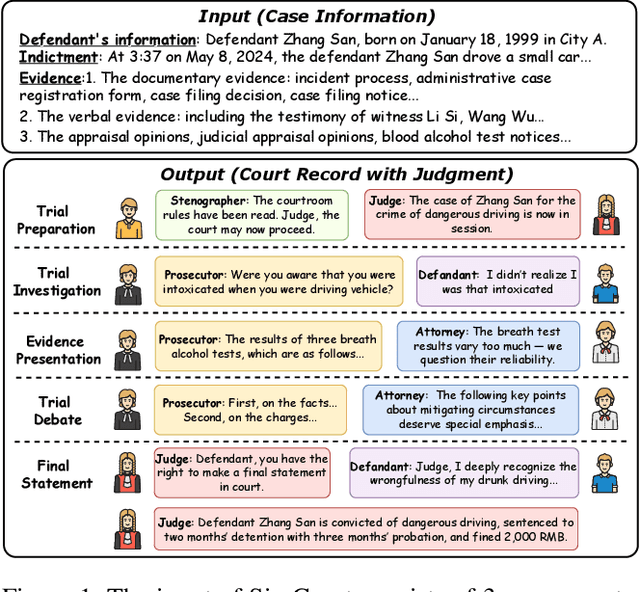

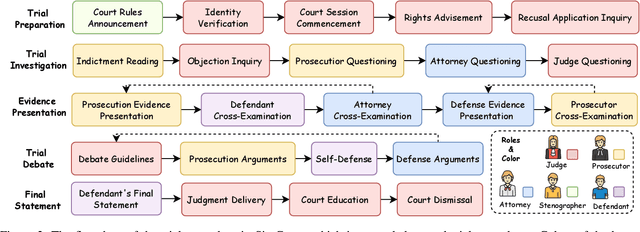

Abstract:Mock trial has long served as an important platform for legal professional training and education. It not only helps students learn about realistic trial procedures, but also provides practical value for case analysis and judgment prediction. Traditional mock trials are difficult to access by the public because they rely on professional tutors and human participants. Fortunately, the rise of large language models (LLMs) provides new opportunities for creating more accessible and scalable court simulations. While promising, existing research mainly focuses on agent construction while ignoring the systematic design and evaluation of court simulations, which are actually more important for the credibility and usage of court simulation in practice. To this end, we present the first court simulation framework -- SimCourt -- based on the real-world procedure structure of Chinese courts. Our framework replicates all 5 core stages of a Chinese trial and incorporates 5 courtroom roles, faithfully following the procedural definitions in China. To simulate trial participants with different roles, we propose and craft legal agents equipped with memory, planning, and reflection abilities. Experiment on legal judgment prediction show that our framework can generate simulated trials that better guide the system to predict the imprisonment, probation, and fine of each case. Further annotations by human experts show that agents' responses under our simulation framework even outperformed judges and lawyers from the real trials in many scenarios. These further demonstrate the potential of LLM-based court simulation.
R-KV: Redundancy-aware KV Cache Compression for Training-Free Reasoning Models Acceleration
May 30, 2025Abstract:Reasoning models have demonstrated impressive performance in self-reflection and chain-of-thought reasoning. However, they often produce excessively long outputs, leading to prohibitively large key-value (KV) caches during inference. While chain-of-thought inference significantly improves performance on complex reasoning tasks, it can also lead to reasoning failures when deployed with existing KV cache compression approaches. To address this, we propose Redundancy-aware KV Cache Compression for Reasoning models (R-KV), a novel method specifically targeting redundant tokens in reasoning models. Our method preserves nearly 100% of the full KV cache performance using only 10% of the KV cache, substantially outperforming existing KV cache baselines, which reach only 60% of the performance. Remarkably, R-KV even achieves 105% of full KV cache performance with 16% of the KV cache. This KV-cache reduction also leads to a 90% memory saving and a 6.6X throughput over standard chain-of-thought reasoning inference. Experimental results show that R-KV consistently outperforms existing KV cache compression baselines across two mathematical reasoning datasets.
OmniResponse: Online Multimodal Conversational Response Generation in Dyadic Interactions
May 27, 2025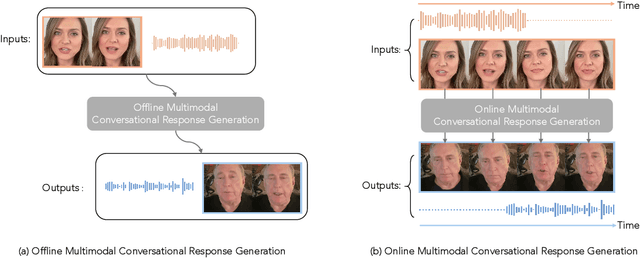
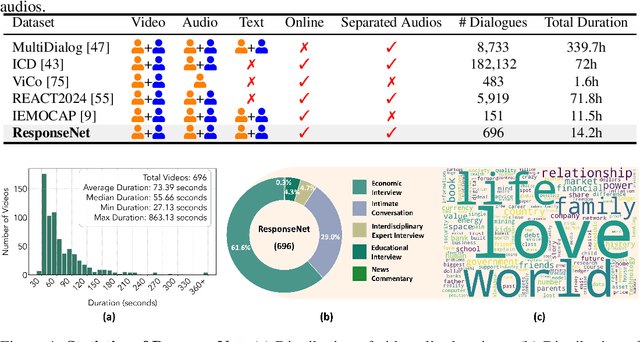
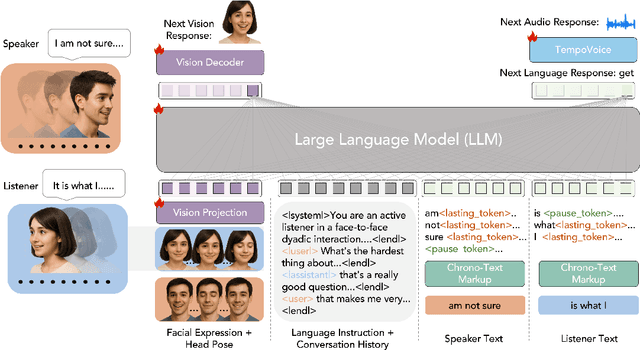
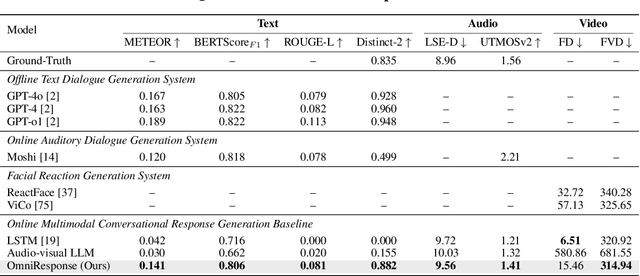
Abstract:In this paper, we introduce Online Multimodal Conversational Response Generation (OMCRG), a novel task that aims to online generate synchronized verbal and non-verbal listener feedback, conditioned on the speaker's multimodal input. OMCRG reflects natural dyadic interactions and poses new challenges in achieving synchronization between the generated audio and facial responses of the listener. To address these challenges, we innovatively introduce text as an intermediate modality to bridge the audio and facial responses. We hence propose OmniResponse, a Multimodal Large Language Model (MLLM) that autoregressively generates high-quality multi-modal listener responses. OmniResponse leverages a pretrained LLM enhanced with two novel components: Chrono-Text, which temporally anchors generated text tokens, and TempoVoice, a controllable online TTS module that produces speech synchronized with facial reactions. To support further OMCRG research, we present ResponseNet, a new dataset comprising 696 high-quality dyadic interactions featuring synchronized split-screen videos, multichannel audio, transcripts, and facial behavior annotations. Comprehensive evaluations conducted on ResponseNet demonstrate that OmniResponse significantly outperforms baseline models in terms of semantic speech content, audio-visual synchronization, and generation quality.
REACT 2025: the Third Multiple Appropriate Facial Reaction Generation Challenge
May 22, 2025Abstract:In dyadic interactions, a broad spectrum of human facial reactions might be appropriate for responding to each human speaker behaviour. Following the successful organisation of the REACT 2023 and REACT 2024 challenges, we are proposing the REACT 2025 challenge encouraging the development and benchmarking of Machine Learning (ML) models that can be used to generate multiple appropriate, diverse, realistic and synchronised human-style facial reactions expressed by human listeners in response to an input stimulus (i.e., audio-visual behaviours expressed by their corresponding speakers). As a key of the challenge, we provide challenge participants with the first natural and large-scale multi-modal MAFRG dataset (called MARS) recording 137 human-human dyadic interactions containing a total of 2856 interaction sessions covering five different topics. In addition, this paper also presents the challenge guidelines and the performance of our baselines on the two proposed sub-challenges: Offline MAFRG and Online MAFRG, respectively. The challenge baseline code is publicly available at https://github.com/reactmultimodalchallenge/baseline_react2025
MOM: Memory-Efficient Offloaded Mini-Sequence Inference for Long Context Language Models
Apr 16, 2025Abstract:Long-context language models exhibit impressive performance but remain challenging to deploy due to high GPU memory demands during inference. We propose Memory-efficient Offloaded Mini-sequence Inference (MOM), a method that partitions critical layers into smaller "mini-sequences" and integrates seamlessly with KV cache offloading. Experiments on various Llama, Qwen, and Mistral models demonstrate that MOM reduces peak memory usage by over 50\% on average. On Meta-Llama-3.2-8B, MOM extends the maximum context length from 155k to 455k tokens on a single A100 80GB GPU, while keeping outputs identical and not compromising accuracy. MOM also maintains highly competitive throughput due to minimal computational overhead and efficient last-layer processing. Compared to traditional chunked prefill methods, MOM achieves a 35\% greater context length extension. More importantly, our method drastically reduces prefill memory consumption, eliminating it as the longstanding dominant memory bottleneck during inference. This breakthrough fundamentally changes research priorities, redirecting future efforts from prefill-stage optimizations to improving decode-stage residual KV cache efficiency.
Algorithm Design and Prototype Validation for Reconfigurable Intelligent Sensing Surface: Forward-Only Transmission
Mar 31, 2025Abstract:Sensing-assisted communication schemes have recently garnered significant research attention. In this work, we design a dual-function reconfigurable intelligent surface (RIS), integrating both active and passive elements, referred to as the reconfigurable intelligent sensing surface (RISS), to enhance communication. By leveraging sensing results from the active elements, we propose communication enhancement and robust interference suppression schemes for both near-field and far-field models, implemented through the passive elements. These schemes remove the need for base station (BS) feedback for RISS control, simplifying the communication process by replacing traditional channel state information (CSI) feedback with real-time sensing from the active elements. The proposed schemes are theoretically analyzed and then validated using software-defined radio (SDR). Experimental results demonstrate the effectiveness of the sensing algorithms in real-world scenarios, such as direction of arrival (DOA) estimation and radio frequency (RF) identification recognition. Moreover, the RISS-assisted communication system shows strong performance in communication enhancement and interference suppression, particularly in near-field models.
Bedrock Models in Communication and Sensing: Advancing Generalization, Transferability, and Performance
Mar 11, 2025



Abstract:Deep learning (DL) has emerged as a powerful tool for addressing the intricate challenges inherent in communication and sensing systems, significantly enhancing the intelligence of future sixth-generation (6G) networks. A substantial body of research has highlighted the promise of DL-based techniques in these domains. However, in addition to improving accuracy, new challenges must be addressed regarding the generalization and transferability of DL-based systems. To tackle these issues, this paper introduces a series of mathematically grounded and modularized models, referred to as bedrock models, specifically designed for integration into both communication and sensing systems. Due to their modular architecture, these models can be seamlessly incorporated into existing communication and sensing frameworks. For communication systems, the proposed models demonstrate substantial performance improvements while also exhibit strong transferability, enabling direct parameter sharing across different tasks, which greatly facilitates practical deployment. In sensing applications, the integration of the bedrock models into existing systems results in superior performance, reducing delay and Doppler estimation errors by an order of magnitude compared to traditional methods. Additionally, a pre-equalization strategy based on the bedrock models is proposed for the transmitter. By leveraging sensing information, the transmitted communication signal is dynamically adjusted without altering the communication model pre-trained in AWGN channels. This adaptation enables the system to effectively cope with doubly dispersive channels, restoring the received signal to an AWGN-like condition and achieving near-optimal performance. Simulation results substantiate the effectiveness and transferability of the proposed bedrock models, underscoring their potential to advance both communication and sensing systems.
Low-Complexity Beamforming Design for Null Space-based Simultaneous Wireless Information and Power Transfer Systems
Mar 11, 2025



Abstract:Simultaneous wireless information and power transfer (SWIPT) is a promising technology for the upcoming sixth-generation (6G) communication networks, enabling internet of things (IoT) devices and sensors to extend their operational lifetimes. In this paper, we propose a SWIPT scheme by projecting the interference signals from both intra-wireless information transfer (WIT) and inter-wireless energy transfer (WET) into the null space, simplifying the system into a point-to-point WIT and WET problem. Upon further analysis, we confirm that dedicated energy beamforming is unnecessary. In addition, we develop a low-complexity algorithm to solve the problem efficiently, further reducing computational overhead. Numerical results validate our analysis, showing that the computational complexity is reduced by 97.5\% and 99.96\% for the cases of $K^I = K^E = 2$, $M = 4$ and $K^I = K^E = 16$, $M = 64$, respectively.
 Add to Chrome
Add to Chrome Add to Firefox
Add to Firefox Add to Edge
Add to Edge